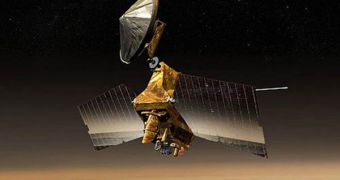Experts at the Jet Propulsion Laboratory (JPL), in Pasadena, California, announce that the NASA-operated Mars Reconnaissance Orbiter (MRO) entered 'safe mode' again on Wednesday, for the fourth time this year. While in this mode, the spacecraft maintains its altitude and direction controls, but all its other features are suspended, until mission controllers upload new sets of commands into the robot's onboard computer.
According to JPL engineers, it could take several days before the orbiter is restored to all its functions. During this time, all of its science instruments will be analyzed, as will its power readings and computer log. During the newest computer reboot, the orbiter did not switch to its back-up system, as it did on its last glitch, in early August. Other reboots similar to this one took place in February and June. In some of these instances, engineers were, and still are, unsure as to what precisely caused these errors to appear. They also want to know now why they are taking place at an increased rate.
One of the main strategies the controllers opted for once the first error started popping up was to order the MRO to start recording large amounts of engineering data onto its non-volatile memory. Their hope was that, during future glitches, the needed data would be preserved and available for recovery later. The hope is now that, after the craft is reverted back to its full function, its recorded data will be used to determine the source of the flaw.
“We hope to gain a better understanding of what is triggering these events and then have the spacecraft safely resume its study of Mars by next week,” JPL expert Jim Erikson, who is the MRO project manager, says of the current efforts. He adds that the orbiter is invaluable for Martian science. Since it began surveying the Red Planet, back in 2006, its six science instruments have collected more data about the atmosphere and surface of Mars than all present and past missions combined.

 14 DAY TRIAL //
14 DAY TRIAL //